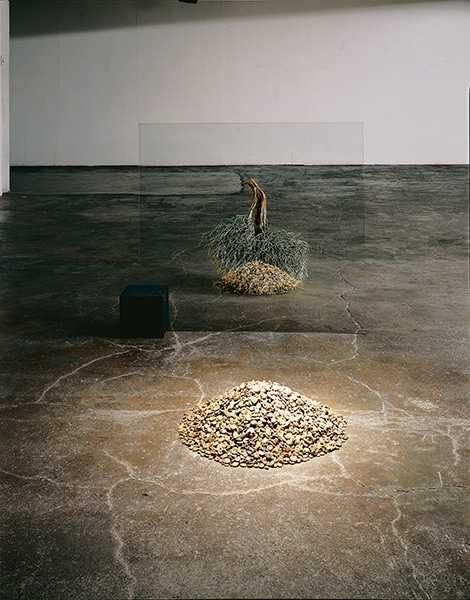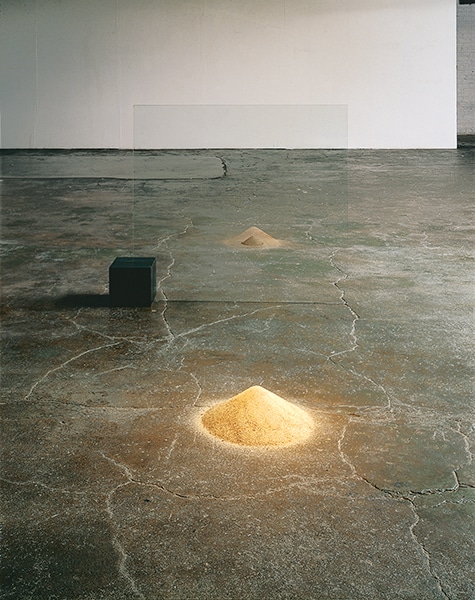Slide Images
1 - Threshold No. 3, 2003
Branch, fossils, glass, bronze
94 cm x 183 cm x 380 cm
37 in x 72 in x 149.5 in
2 - Threshold No. 2, 2003
Sand, earth, bronze, glass, bronze
94 cm x 183 cm x 380 cm
37 in x 72 in x 149.5 in
Threshold
I spent many nights in my studio exploring possibilities of shadows, reflections, refractions and projections: new discoveries revealed themselves.
Threshold no. 1, 2003.
“Threshold (seuil, en français) c’est le titre d’une œuvre compose d’un tas de pierre et d’une sorte de rond bol, jatte en aluminium., vide. Pierres (de nature) et bol (fabriqué) sont posés sur le sol, a distance. Entre le deux, un vitre. Qui sépare. Mais aussi, en un sens, qui les rapproche, voire les confond, parce qu’en elle, si on se tient au bon endroit, on peu voir, en reflet, le tas de pierres blanches dans le grand bol, comme s’il venait soudain se remplir et les contenir toutes. D’un côté un amas multiple, une dispersion, une pluralité, un tas de petits-uns, et de l’autre un vase ouvert et accueillant, la belle forme unie, lisse et vide, centre creux enveloppant d’un Grand-Un. Mais c’est dans un reflet. Par illusion. La pluralité réelle des pierres ne s’unifie, ne fait groupe, ne fait corps, ne fait Un que dans la virtualité et l’illusion d’un reflet.
Juste un question : Où est l’œuvre? Est-ce le tas de cailloux et la grande jatte? Est-ce la vitre entre les deux? Est-ce le regard du spectateur où s’imprime le reflet? […]
-Gérard Wajcman, Sylvia Safdie Autres territoires, Services culturels de l'Ambassade du Canada, collection Esplanade, Paris, 2000, pg 52-53.
"Threshold is the title of a work composed of a pile of stones and a kind of empty aluminum bowl or jar. Stones (nature) and bowl (fabrication) are set on the floor at a distance. Between the two is a sheet of glass. A separation. But in one sense it draws them closer, and even confounds them, because if one stands in the right place one can see, in reflection, the pile of stones in the bowl, as if it had just been filled and now contained them all. On one side, a multiple mass, a dispersion, a plurality, a pile of little bits; and on the other an open, welcoming vase, a beautiful unified form, smooth and empty, a hollow enveloping Oneness. In sum, in this work, the multiple, the unformed, the dispersed, take form and unify themselves in a large vase, a whole tribe of little-ones united in and by this Oneness. But it's a reflection, an illusion. The real plurality of stone is not unified; it makes no group, no body, no Whole, except in the virtuality and the illusion of a reflection.
A question though: where is the work? Is it a pile of pebbles and the large basin? Is it the glass between them? Is it the reflection in the glass where the images meet? Is it in the gaze of the spectator where the reflection in imprinted?"
-Gérard Wajcman, translated by Lucie McNair, Sylvia Safdie Autres territoires, Services culturels de l'Ambassade du Canada, collection Esplanade, Paris, 2000, pg 52-53.
Threshold No 2, 2003
Threshold No. 2 consists of a mound of sand which I collected on the shores of the Mediterranean in Haifa and a smaller mound of black earth which I collected in Quebec's Eastern Townships. They are divided by a glass pane.
“…in the series Threshold No. 2- black earth, sand and installation in which Safdie uses projection and perception as pivotal reminders of the illusory quality of boundaries and what they reveal. Divided by a glass screen and transformed by light, the palimpsest ‘reading’ of two opposing piles – their origins in the respective epidermises of Haifa and Quebec’s Eastern Township effaced long ago, or of a larger, more textural pile reflectively ‘embedded’ in the crown of an invented bush is about alterity, about the most hermeneutical way in which the ‘sum of all that we have ‘is at the same time our destiny and our enigma."
-Irena Zantovska Murray: “Sylvia Safdie, The Inventory of Invention” pg. 24, Leonard and Bina Ellen Art Gallery, 2000. Photo: Richard-Max Tremblay.
Threshold No. 3, 2003
In Threshold No. 3, a pile of fossils and a dried branch are set on the floor at a distance. Between the two stands a sheet of glass - a separation. But in one sense it draws them closer, and even confounds them, because if one stands in the right place, one can see, in reflection, the pile of fossils in the branch, as if the fossils have just become 'one' with the branch.

